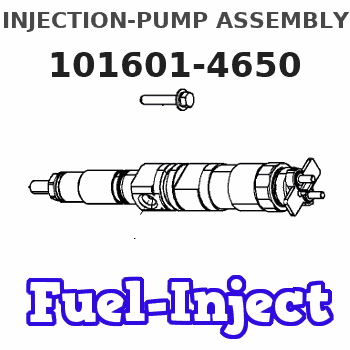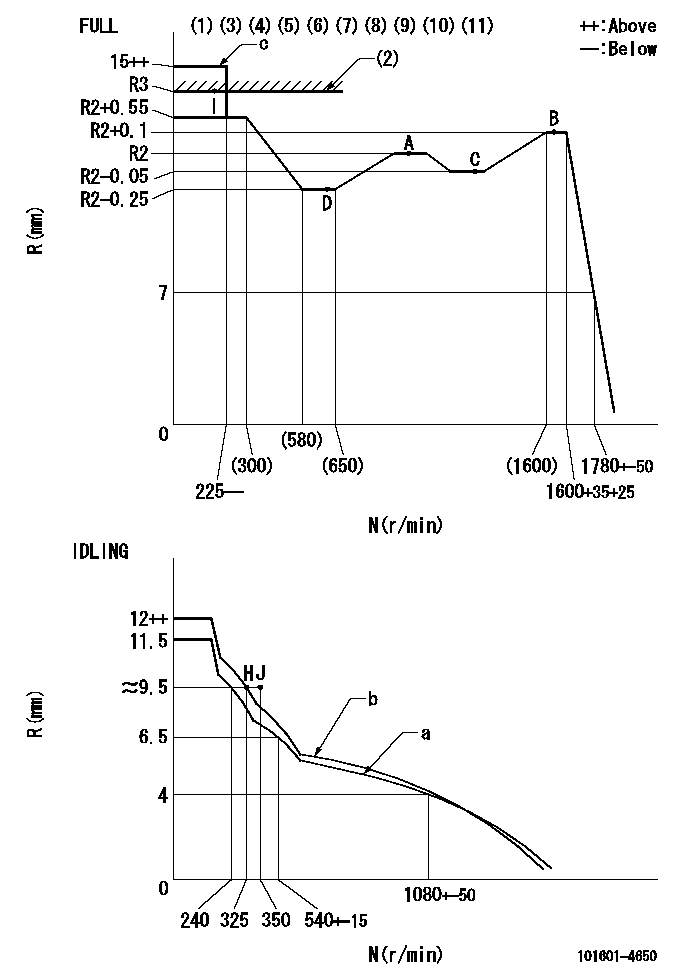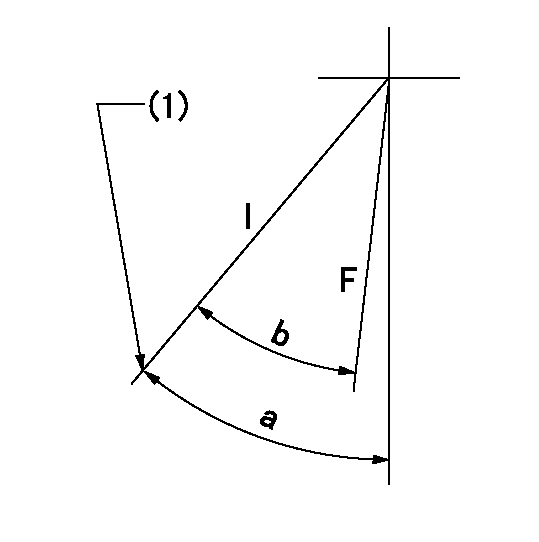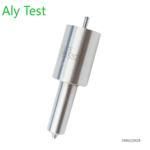Information injection-pump assembly
ZEXEL
101601-4650
1016014650
ISUZU
5156009602
5156009602

Rating:
Service parts 101601-4650 INJECTION-PUMP ASSEMBLY:
1.
_
7.
COUPLING PLATE
8.
_
9.
_
11.
Nozzle and Holder
5-15300-089-1
12.
Open Pre:MPa(Kqf/cm2)
18.1{185}
15.
NOZZLE SET
Cross reference number
ZEXEL
101601-4650
1016014650
ISUZU
5156009602
5156009602
Zexel num
Bosch num
Firm num
Name
101601-4650
5156009602 ISUZU
INJECTION-PUMP ASSEMBLY
6BD1 * K
6BD1 * K
Calibration Data:
Adjustment conditions
Test oil
1404 Test oil ISO4113 or {SAEJ967d}
1404 Test oil ISO4113 or {SAEJ967d}
Test oil temperature
degC
40
40
45
Nozzle and nozzle holder
105780-8140
Bosch type code
EF8511/9A
Nozzle
105780-0000
Bosch type code
DN12SD12T
Nozzle holder
105780-2080
Bosch type code
EF8511/9
Opening pressure
MPa
17.2
Opening pressure
kgf/cm2
175
Injection pipe
Outer diameter - inner diameter - length (mm) mm 6-2-600
Outer diameter - inner diameter - length (mm) mm 6-2-600
Overflow valve
132424-0620
Overflow valve opening pressure
kPa
157
123
191
Overflow valve opening pressure
kgf/cm2
1.6
1.25
1.95
Tester oil delivery pressure
kPa
157
157
157
Tester oil delivery pressure
kgf/cm2
1.6
1.6
1.6
Direction of rotation (viewed from drive side)
Right R
Right R
Injection timing adjustment
Direction of rotation (viewed from drive side)
Right R
Right R
Injection order
1-5-3-6-
2-4
Pre-stroke
mm
3.6
3.55
3.65
Beginning of injection position
Drive side NO.1
Drive side NO.1
Difference between angles 1
Cal 1-5 deg. 60 59.5 60.5
Cal 1-5 deg. 60 59.5 60.5
Difference between angles 2
Cal 1-3 deg. 120 119.5 120.5
Cal 1-3 deg. 120 119.5 120.5
Difference between angles 3
Cal 1-6 deg. 180 179.5 180.5
Cal 1-6 deg. 180 179.5 180.5
Difference between angles 4
Cyl.1-2 deg. 240 239.5 240.5
Cyl.1-2 deg. 240 239.5 240.5
Difference between angles 5
Cal 1-4 deg. 300 299.5 300.5
Cal 1-4 deg. 300 299.5 300.5
Injection quantity adjustment
Adjusting point
A
Rack position
11.1
Pump speed
r/min
1000
1000
1000
Average injection quantity
mm3/st.
66.8
65.3
68.3
Max. variation between cylinders
%
0
-2.5
2.5
Basic
*
Fixing the rack
*
Standard for adjustment of the maximum variation between cylinders
*
Injection quantity adjustment_02
Adjusting point
H
Rack position
9.5+-0.5
Pump speed
r/min
325
325
325
Average injection quantity
mm3/st.
9.3
8
10.6
Max. variation between cylinders
%
0
-14
14
Fixing the rack
*
Standard for adjustment of the maximum variation between cylinders
*
Injection quantity adjustment_03
Adjusting point
A
Rack position
R2(11.1+
-0.5)
Pump speed
r/min
1000
1000
1000
Average injection quantity
mm3/st.
66.8
65.8
67.8
Basic
*
Fixing the lever
*
Injection quantity adjustment_04
Adjusting point
B
Rack position
11.2+-0.
5
Pump speed
r/min
1600
1600
1600
Average injection quantity
mm3/st.
74
72.4
75.6
Fixing the lever
*
Injection quantity adjustment_05
Adjusting point
C
Rack position
11.05+-0
.5
Pump speed
r/min
1300
1300
1300
Average injection quantity
mm3/st.
71
69.4
72.6
Fixing the lever
*
Injection quantity adjustment_06
Adjusting point
D
Rack position
10.85+-0
.5
Pump speed
r/min
650
650
650
Average injection quantity
mm3/st.
48
46.4
49.6
Fixing the lever
*
Injection quantity adjustment_07
Adjusting point
E
Rack position
10.95+-0
.5
Pump speed
r/min
550
550
550
Average injection quantity
mm3/st.
46.2
44.2
48.2
Fixing the lever
*
Injection quantity adjustment_08
Adjusting point
F
Rack position
11.25+-0
.5
Pump speed
r/min
450
450
450
Average injection quantity
mm3/st.
50
48
52
Fixing the lever
*
Injection quantity adjustment_09
Adjusting point
I
Rack position
R3(13.6+
-0.5)
Pump speed
r/min
150
150
150
Average injection quantity
mm3/st.
82
82
87
Fixing the rack
*
Timer adjustment
Pump speed
r/min
1350
Advance angle
deg.
0.5
Timer adjustment_02
Pump speed
r/min
1400
Advance angle
deg.
1.3
Timer adjustment_03
Pump speed
r/min
1500
Advance angle
deg.
2.3
1.8
2.8
Timer adjustment_04
Pump speed
r/min
1600
Advance angle
deg.
4
3.5
4.5
Remarks
Finish
Finish
Test data Ex:
Governor adjustment

N:Pump speed
R:Rack position (mm)
(1)Torque cam stamping: T1
(2)RACK LIMIT
(3)Because the figures in brackets are the target values at torque cam adjustment, perform final adjustment in accordance with governor and injection quantity adjustment standards.
(4)Perform governor spring adjustment by setting lever a.
(5)After adjustment of the lever a setting, set the lever so that idle set point H can be obtained and confirm standard b.
(6)After completing final adjustment, set the lever to obtain J.
(7)Next, confirm rack position R1 or more is obtained when rotation is stopped.
(8)In this condition, move the lever to the full position and confirm standard c. (excess fuel for starting operation limit).
(9)After completing final adjustment, set speed at N1 using lever b.
(10)In this condition, after operating the lever to the full position, confirm no excess fuel for starting (black smoke prevention limit).
(11)For the excess fuel setting for starting rack position point I set the lever to obtain standard c in step (8) and then set the rack limit.
----------
T1=01 R1=12mm N1=225r/min
----------
----------
T1=01 R1=12mm N1=225r/min
----------
Speed control lever angle

F:Full speed
I:Idle
(1)Stopper bolt set position 'b.'
----------
----------
a=40deg+-5deg b=39deg+-3deg
----------
----------
a=40deg+-5deg b=39deg+-3deg
Information:
Charging System
The condition of charge in the battery at each regular inspection will show if the charging system operates correctly. An adjustment is necessary when the battery is constantly in a low condition of charge or a large amount of water is needed (more than one ounce of water per cell per week or per every 100 service hours).When it is possible, make a test of the charging unit and voltage regulator on the engine, and use wiring and components that are a permanent part of the system. Off-engine (bench) testing will give a test of the charging unit and voltage regulator operation. This testing will give an indication of needed repair. After repairs are made, again make a test to give proof that the units are repaired to their original condition of operation.Before the start of on-engine testing, the charging system and battery must be checked as shown in the Steps that follow:1. Battery must be at least 75% (1.225 Sp. Gr.) fully charged and held tightly in place. The battery holder must not put too much stress on the battery.2. Cables between the battery, starter and engine ground must be the correct size. Wires and cables must be free of corrosion and have cable support clamps to prevent stress on battery connections (terminals).3. Leads, junctions, switches and panel instruments that have direct relation to the charging circuit must give correct circuit control.4. Inspect the drive components for the charging unit to be sure they are free of grease and oil and have the ability to operate the charging unit.Delco-Remy Alternator; Pulley Nut Tightening
Tighten nut that holds the pulley to a torque of 100 7 N m (75 5 lb ft) with the tools shown.
Tools To Tighten Alternator Pulley Nut
(1) 8T9293 Torque Wrench. (2) 8S1588 Adapter (1/2" female to 3/8" male). (3) 2P8267 Socket Assembly. (4) 8H8517 Combination Wrench (1 1/8"). (5) 8T5314 Socket.Alternator Regulator Adjustment - (Delco-Remy)
When an alternator is charging the battery too much or not enough, an adjustment can be made to the charging rate of the alternator. Make reference to the Specifications section to find all testing specifications for the alternators and regulators.3T6352 Alternator 24V 35A (Delco-Remy Number 1117647)
3T6352 AlternatorNo adjustment can be made to change the rate of charge on the alternator regulator. If rate of charge is not correct, a replacement of the regulator is necessary.7N9720 Alternator 24V 35A (Bosch Number 0-122-469-001)
7N9720 AlternatorThe solid state regulator used with the Bosch Alternator is totally enclosed and non-adjustable. If the rate of charge is not correct a replacement of the regulator is necessary.9G4574 24V 35A (Nippondenso Number 100211-0860)
9G4574 AlternatorNo adjustment can be made to change the rate of charge on the alternator regulator. If rate of charge is not correct, a replacement of the regulator is necessary.Starting System
Use the multimeter in the DCV range to find starting system components which do not function.Move the start control switch to activate the starter solenoid. Starter solenoid operation can be heard as the pinion
The condition of charge in the battery at each regular inspection will show if the charging system operates correctly. An adjustment is necessary when the battery is constantly in a low condition of charge or a large amount of water is needed (more than one ounce of water per cell per week or per every 100 service hours).When it is possible, make a test of the charging unit and voltage regulator on the engine, and use wiring and components that are a permanent part of the system. Off-engine (bench) testing will give a test of the charging unit and voltage regulator operation. This testing will give an indication of needed repair. After repairs are made, again make a test to give proof that the units are repaired to their original condition of operation.Before the start of on-engine testing, the charging system and battery must be checked as shown in the Steps that follow:1. Battery must be at least 75% (1.225 Sp. Gr.) fully charged and held tightly in place. The battery holder must not put too much stress on the battery.2. Cables between the battery, starter and engine ground must be the correct size. Wires and cables must be free of corrosion and have cable support clamps to prevent stress on battery connections (terminals).3. Leads, junctions, switches and panel instruments that have direct relation to the charging circuit must give correct circuit control.4. Inspect the drive components for the charging unit to be sure they are free of grease and oil and have the ability to operate the charging unit.Delco-Remy Alternator; Pulley Nut Tightening
Tighten nut that holds the pulley to a torque of 100 7 N m (75 5 lb ft) with the tools shown.
Tools To Tighten Alternator Pulley Nut
(1) 8T9293 Torque Wrench. (2) 8S1588 Adapter (1/2" female to 3/8" male). (3) 2P8267 Socket Assembly. (4) 8H8517 Combination Wrench (1 1/8"). (5) 8T5314 Socket.Alternator Regulator Adjustment - (Delco-Remy)
When an alternator is charging the battery too much or not enough, an adjustment can be made to the charging rate of the alternator. Make reference to the Specifications section to find all testing specifications for the alternators and regulators.3T6352 Alternator 24V 35A (Delco-Remy Number 1117647)
3T6352 AlternatorNo adjustment can be made to change the rate of charge on the alternator regulator. If rate of charge is not correct, a replacement of the regulator is necessary.7N9720 Alternator 24V 35A (Bosch Number 0-122-469-001)
7N9720 AlternatorThe solid state regulator used with the Bosch Alternator is totally enclosed and non-adjustable. If the rate of charge is not correct a replacement of the regulator is necessary.9G4574 24V 35A (Nippondenso Number 100211-0860)
9G4574 AlternatorNo adjustment can be made to change the rate of charge on the alternator regulator. If rate of charge is not correct, a replacement of the regulator is necessary.Starting System
Use the multimeter in the DCV range to find starting system components which do not function.Move the start control switch to activate the starter solenoid. Starter solenoid operation can be heard as the pinion
Have questions with 101601-4650?
Group cross 101601-4650 ZEXEL
Isuzu
101601-4650
5156009602
INJECTION-PUMP ASSEMBLY
6BD1
6BD1
